Almond milk yogurt tastes amazing and is easy to make at home with or without an Instant Pot or yogurt maker. All you need are 5 ingredients and a few minutes of hands-on time. Then let it culture overnight, and wake up to perfectly tangy, healthy homemade almond yogurt! Naturally soy-free, gluten-free, and coconut-free.
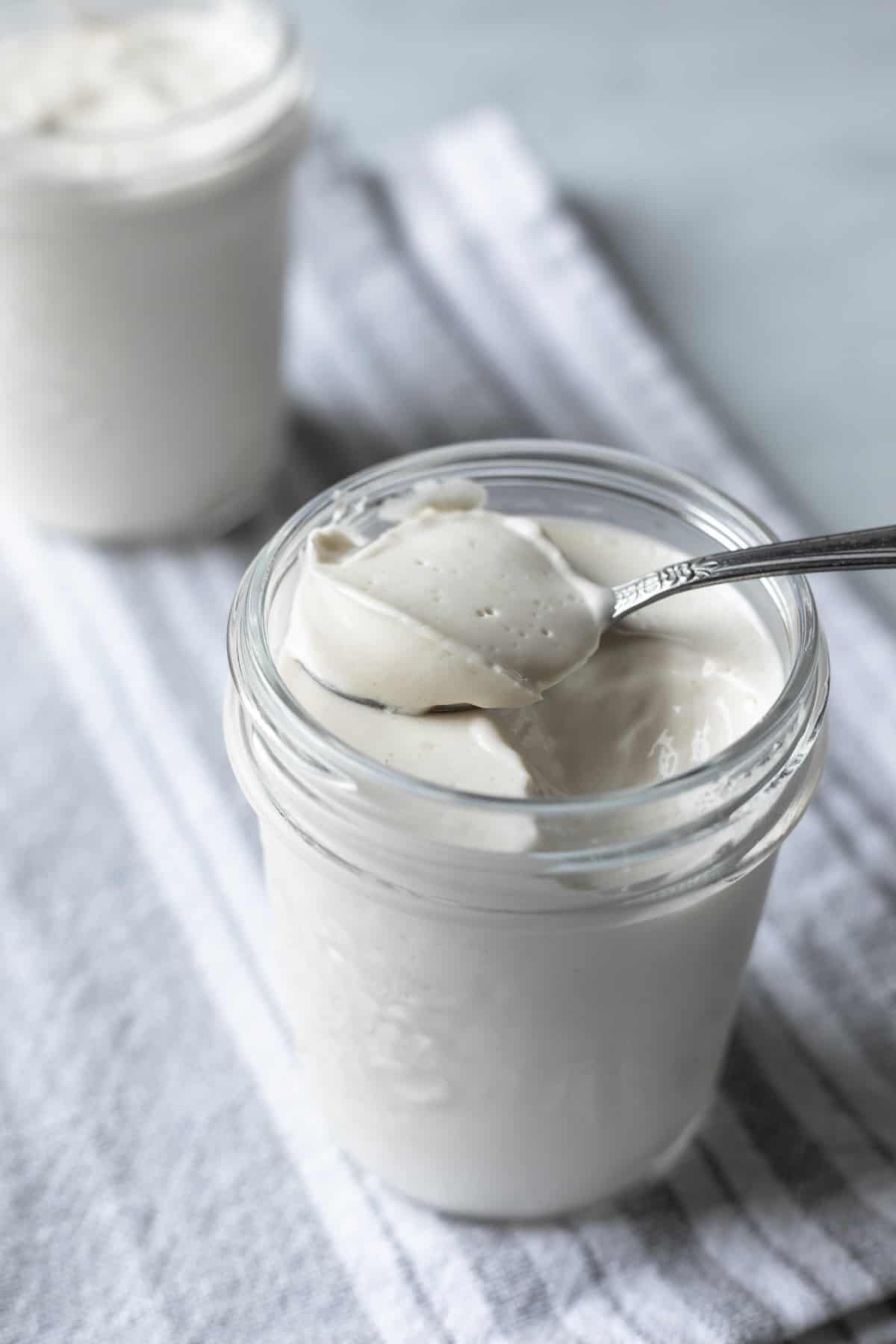
After falling in love with homemade cashew yogurt, I finally got around to experimenting with almond milk yogurt, and now I have TWO favorite ways to make dairy-free yogurt at home!
Honestly, the flavor of this almond yogurt surprised me. It tastes so clean, pure, and simple. That's really the best way to describe it.
The main difference in preparation between cashew yogurt and almond yogurt is that almond milk doesn't thicken on its own without a little help. So we're including a starch and a small amount of agar agar to help the yogurt set.
Related: Check out this new tofu yogurt recipe. It's super quick and easy!
Jump to:
Why You'll Love It
This healthy non-dairy yogurt:
- is SO creamy, clean, and rich-tasting.
- cuts down on single-use plastic containers.
- can be more or less tangy, depending on your preference.
- is unsweetened other than 1 tablespoon of maple syrup to help the culturing process. So it's also suitable for use in savory dishes like our favorite vegan mashed potatoes!
- contains no gums.
- and it can be sweetened and flavored any way you like. From jam to fruit puree to maple syrup, add your favorite sweetener to individual servings for ultimate flexibility.
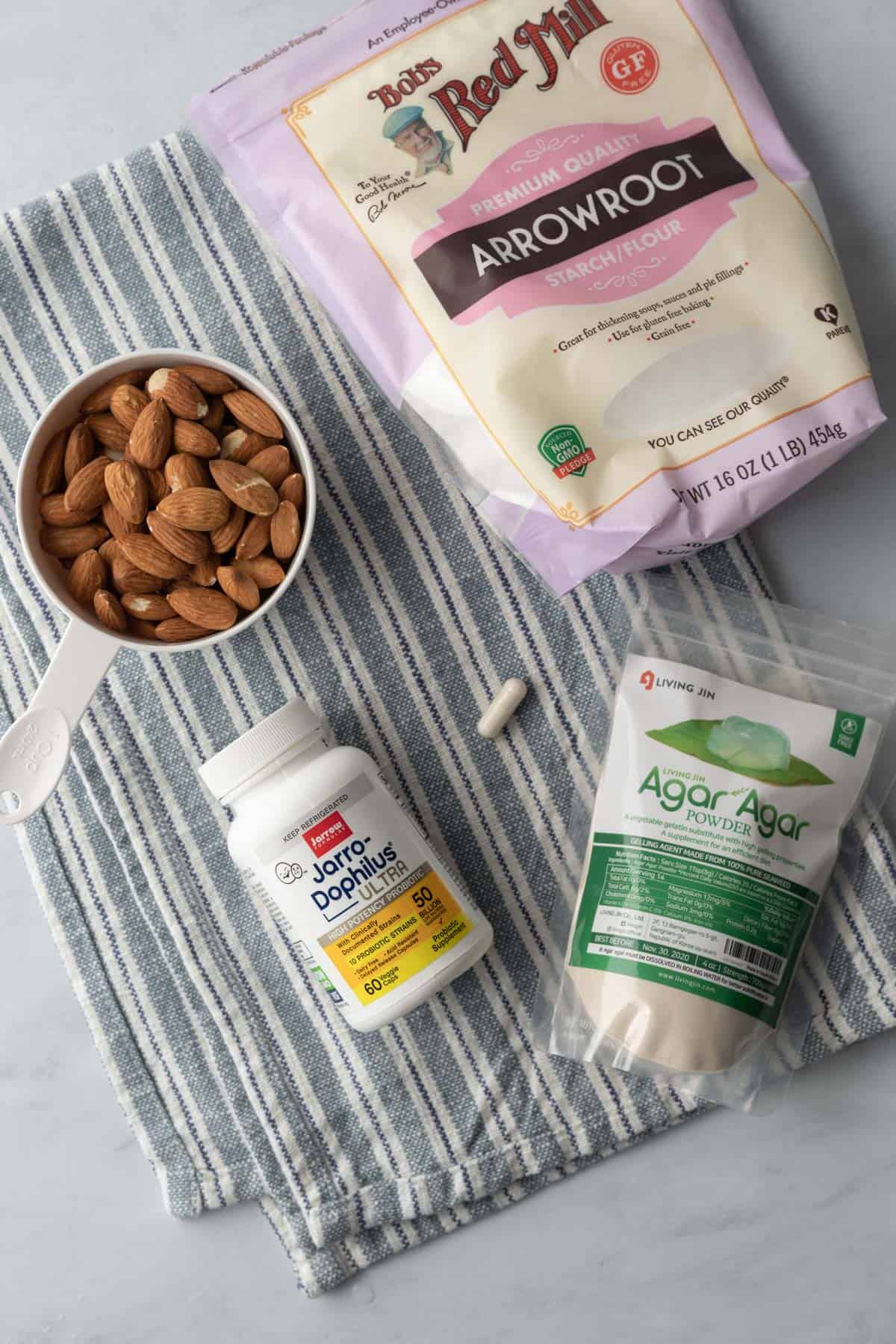
Ingredient Notes
- Raw Almonds - in the U.S., technically almonds labeled as "raw" aren't raw at all. They are steam treated for food safety. But "raw" is what you want to look for on the label or bulk bin.
- Maple Syrup - almonds are lower in carbohydrates than cashews, so this yogurt needs a touch of added sugar to help it culture. Feel free to use another type of sweetener if you don't have maple syrup on hand. Note: it's such a small amount that it doesn't make the yogurt taste sweet; the end result tastes like sugar-free, plain yogurt.
- Probiotic or Yogurt Starter Culture - This is important! If using probiotic capsules you need one with live active cultures. I use this high-potency, multi-strain probiotic by Jarrow. For the most consistent results I recommend using a similar product.
With this particular probiotic you'll only need ONE capsule because each capsule contains 50 billion live bacteria. If using a probiotic with fewer live active cultures, you may need to use more capsules.
Per batch of yogurt aim for around 30 to 40 billion live active cultures. Also, the probiotic should contain L. acidophilus and B. lactis. - Arrowroot Starch - I almost always have arrowroot in the pantry because it's a great thickener for desserts, soups, and sauces. You may substitute corn starch or tapioca if needed.
- Agar Agar Powder - this seaweed-based vegan "gelatin" is such a useful ingredient! I use it to create healthy desserts, like these lightened-up lemon bars, and for the perfect texture in my Vegan Feta Cheese and Vegan Cream Cheese. Agar keeps for a long time in the pantry. If you decide to omit it, the yogurt will still taste great but will be quite a bit thinner, more like kefir.
See the recipe card at the bottom of the post for amounts and full instructions.
Instructions
Making almond yogurt at home is easier than you might think. Here's an overview of the process.
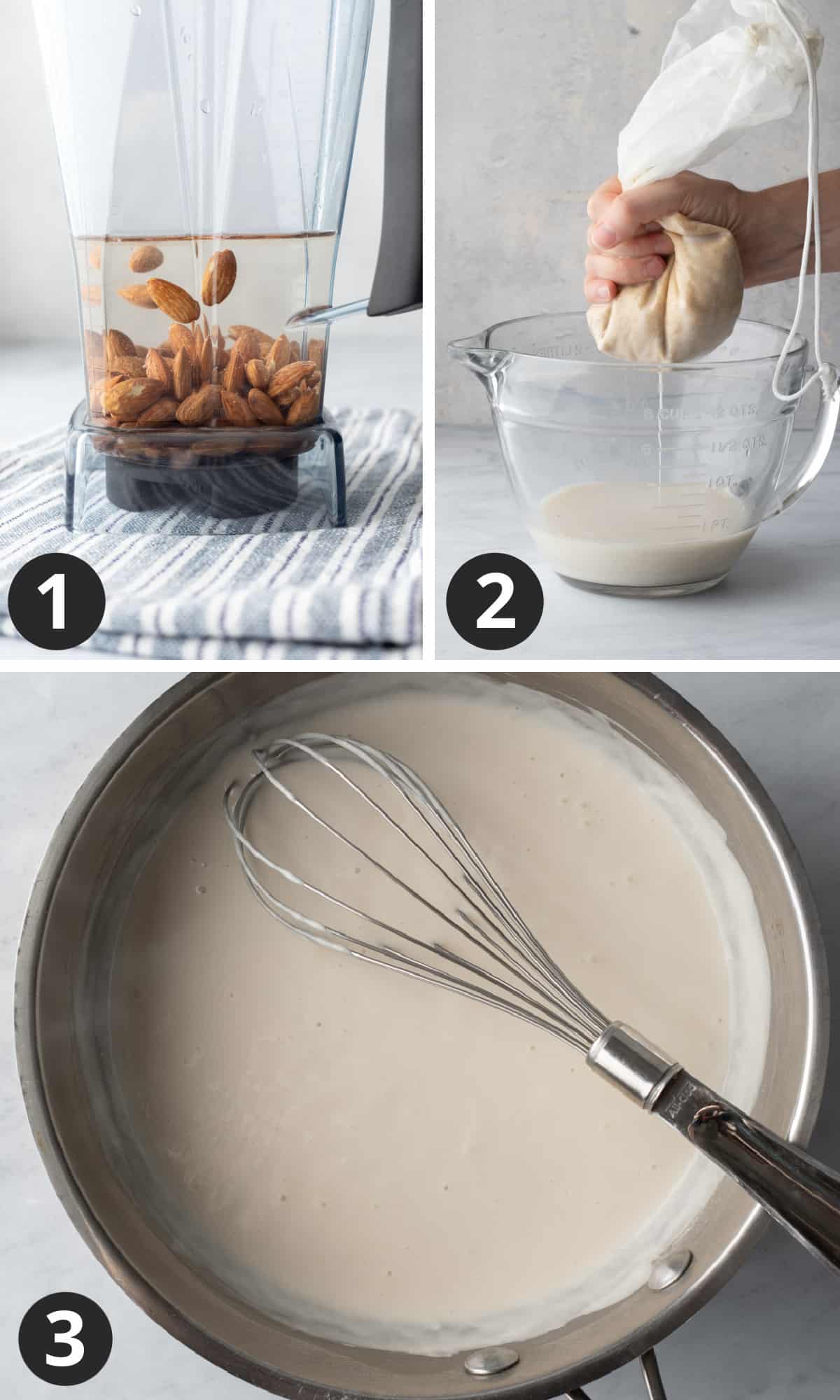
- Begin by making almond milk. Blend 1 cup of raw almonds with 2 cups of fresh water and a tablespoon of maple syrup.
- Strain the milk with a nut milk bag. TIP! Don't discard the pulp; use it to make almond pulp energy balls or granola bars.
- In a saucepan combine the almond milk, 1 additional cup of water, arrowroot, and agar. Whisk to dissolve, then slowly bring the mixture to a simmer, whisking frequently.
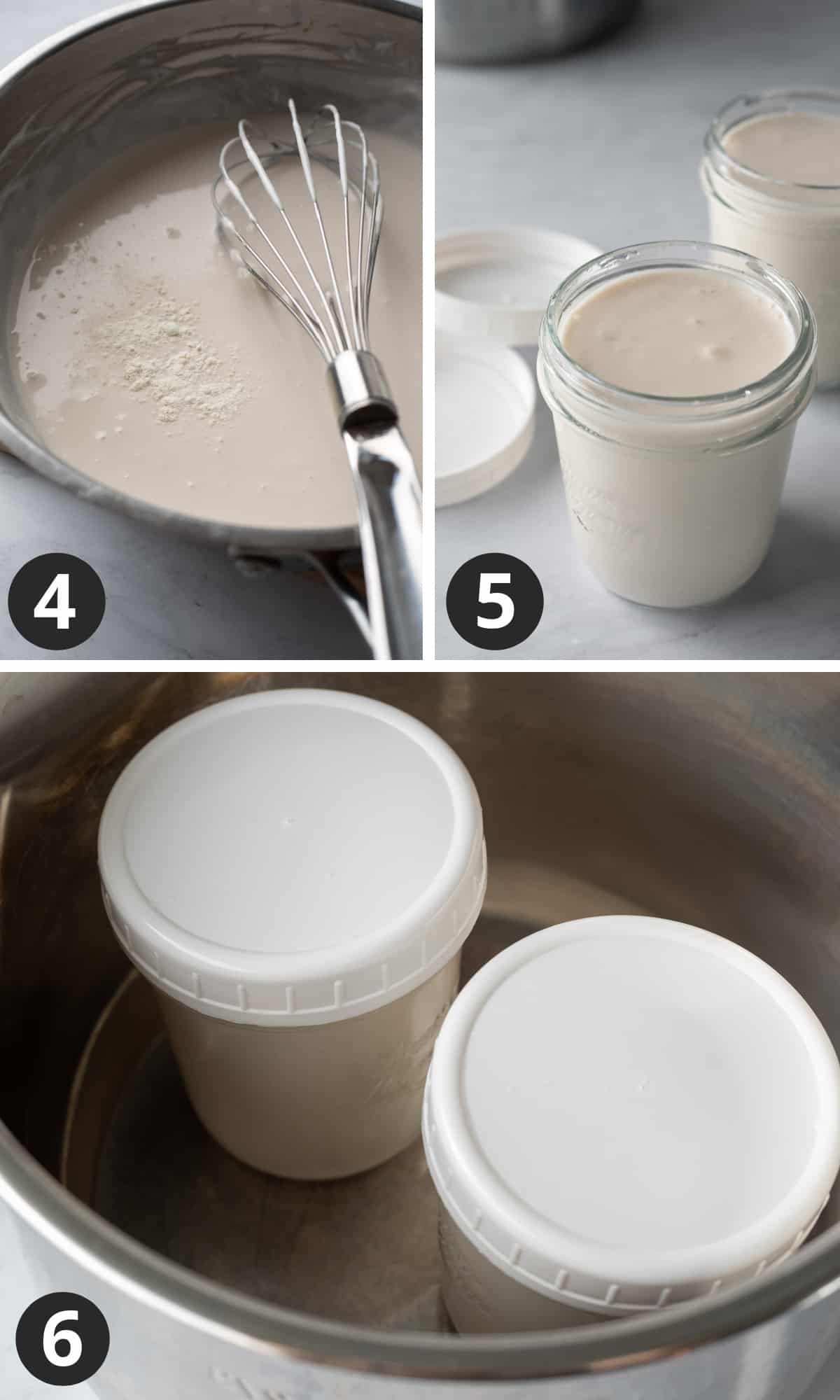
- Once the milk has thickened and simmered for about 2 minutes, remove from heat. Let cool for 30 minutes or until it has reached 105 degrees F. If you don't have a thermometer, drop a little on the back of your hand - it should feel warm but NOT hot. If it's too hot it will kill the probiotics. Open the probiotic capsule(s) and sprinkle the powder onto the milk (discard the capsule). Whisk to combine.
- Immediately pour into clean lidded jars (see tip below for an easy way to ensure the jars are clean).
- Place in the Instant Pot, if using, lock on the lid, and use the yogurt function to set the time. See below for other ideas and ways to culture the yogurt without an Instant Pot.
📩 Want to save this recipe?
Keep an eye out for more delicious recipes. Unsubscribe anytime.
Tip: if using an Instant Pot to culture the yogurt, there's no need to add water to the pot.
Substitutions
- Maple Syrup - as mentioned above, a small amount of sugar helps the culturing process since almonds are naturally very low in sugars and carbohydrates. Feel free to substitute cane sugar or agave syrup if you don't have maple syrup.
- Arrowroot - corn starch or tapioca starch may be used instead.
- Agar - if you don't mind thinner yogurt with a consistency more like kefir, feel free to omit the agar. There isn't a comparable substitute that's vegan.
Equipment
- Blender - A high speed blender like a Vitamix works best to create almond milk, but don't fret if you only have a standard blender. To help the blender along, soak the almonds overnight or in hot water for about 2 hours before blending.
- Nut milk bag - You'll need a way to strain the almond milk. I use these nylon nut milk bags. They're inexpensive, sturdy, and easy to clean. A fine mesh strainer lined with cheesecloth is another option.
Bonus! Once you have nut milk bags you can also use them for oat milk, condensed oat milk, and oat milk creamer! - Instant Pot - if you have an IP with the yogurt function, you're golden! It makes the process of making yogurt so very simple. Don't have an Instant Pot? See the next section for multiple other ways to culture the yogurt.
How to Make Vegan Yogurt Without an Instant Pot
The goal is to keep the almond milk at a fairly constant 105 to 110 degrees F during the culturing period.
But before you start stressing about it, keep in mind humans have been making yogurt for thousands and thousands of years without the help of electricity or kitchen appliances!
While an Instant Pot with yogurt function makes the process very easy, it's certainly not the only way to make yogurt at home. Here are a few alternative methods:
- Fill an insulated cooler with warm water (110 degrees) up to the necks of the jars, and keep the cooler closed.
- Place the jars in a draft-free spot in the house. Wrap them with a towel, and wrap a heating pad around the towel. Set it on low, cycling it on and off if needed so that it doesn't get too warm.
- Pre-heat a slow cooker, then turn it off. Line it with a towel, and set the jars on the towel. Cover with the lid and another towel for added insulation. Occasionally turn on the "warm" function if needed.
- Find a warm, sunny spot in the house. Wrap the jars with a towel, and place in the sun.
Storage
Store the jar(s) of yogurt in the refrigerator and use within 1 week.
As with any yogurt, a small amount of water may separate during storage. Either discard it, or stir it back into the yogurt.
Top Tips and Troubleshooting
Make sure your utensils and other equipment are clean, and use good common sense to avoid contamination.
- Heating the almond milk is a critical step. This kills any unwanted bacteria or mold spores that may have made it into the milk via the blender or nut milk bag. Heating also activates the starch and agar which thickens the yogurt.
- Avoid double dipping of spoons or dipping fingers into the almond milk once it has been heated.
- If the yogurt develops a pinkish color, often referred to as "pink mold," this indicates contamination with bacteria, and the yogurt should be discarded.
- But if that happens, don't give up! Review your process and environment, and identify potential ways the bacteria made it into the yogurt.
- Remember, different buildings and environments have varying levels of bacteria and mold in the air. You may need to take extra precautions with the next batch. Sterilize the jars, lids, and all utensils. And while the milk is cooling (before adding the probiotic) place the pot in a safe spot where there isn't a lot of action or air disturbance.
Most importantly, don't let these tips scare you away from making yogurt at home. My goal is to make sure you have success on the first try, which means sharing as much information as possible.
Your efforts will be rewarded with creamy, delicious, affordable, homemade vegan yogurt!
Recipe Video
Recipe
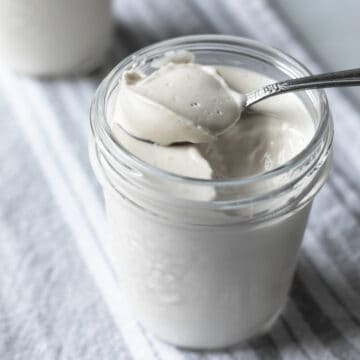
Homemade Almond Milk Yogurt (Vegan)
Equipment
- pint jars - or other size, as long as it fits in IP
- 6-quart instant pot - optional
Ingredients
- 1 cup whole raw almonds
- 3 cups water, divided
- 1 tablespoon maple syrup
- 3 tablespoons arrowroot starch
- ½ teaspoon agar agar powder
- 1 capsule vegan probiotic - Or more; aim for 20-30 billion live bacteria. SEE NOTES below
Instructions
- If not using a high-speed blender, soak almonds overnight or in hot water for about 2 hours. Then drain and rinse.
- In a blender combine almonds with 2 cups of water and the maple syrup. Blend for 30 seconds, then stop to scrape down the sides, if needed. Blend again until the almonds are fully broken down, about 1 minute.
- Using a nut milk bag, strain the almond milk into a medium/large non-reactive sauce pan (stainless steel is fine). Squeeze out as much liquid as possible (save the pulp for another use; see Notes below for suggestions). To the pot add the remaining 1 cup water, arrowroot starch, and agar powder, and whisk to dissolve. Do NOT add the probiotic yet.
- Place the pot over medium heat, and slowly (so it doesn't scald) bring the milk just to a boil. Whisk frequently as the milk is coming to temperature. Once bubbles are rising to the surface, the milk has reached a slow/low boil. Reduce heat to maintain a simmer, and whisking constantly, cook for about 2 minutes. This step is important for killing unwanted bacteria and activating the starch and agar, which thickens the yogurt. Remove from heat.
- Allow the mixture to cool for about 30 minutes or until it reaches 100 to 110 degrees F. Tip: I like to leave the whisk resting in the pot so it stays clean. You may want to whisk the mixture several times as it cools to keep it smooth. If you don't have a thermometer, use a clean spoon and taste the mixture, or drop a bit onto your wrist to test the temperature. If it feels warm (similar to body temperature) but not hot, it's safe to add the probiotic. If the mixture is too warm it will kill the probiotics.
- Open the probiotic capsule(s), and sprinkle the powdered contents onto the almond milk. Discard the capsule(s). Whisk the probiotic powder into the milk. Immediately pour into 2 clean glass pint jars or 1 quart jar, but don't fill the jars all the way to the rim. It's best to leave a bit of space so that the yogurt is not in contact with the lid. Cover with clean lid(s).
- *If not using an Instant Pot use one of the alternate methods described in the Notes section below.* Otherwise, place the jars in the Instant Pot (no need to add water), secure the lid, and click it into the locked/sealed position. Press the Yogurt button, and use the +/- buttons to adjust the time. For less tangy yogurt, try 10 hours (this is the default time for some IP models). For tangier yogurt choose 12 to 14 hours of incubation (I do 12 hours). Don't disturb the yogurt during incubation.
- When the timer beeps, remove jars from the Instant Pot. Allow to cool to room temperature, then refrigerate. Always use clean utensils when scooping out individual portions. Storage: Keep the yogurt refrigerated, and enjoy within 7 days. As with any yogurt a small amount of water may separate during storage. Either discard it, or stir it back into the yogurt.
Notes
- Fill an insulated cooler with warm water (110 degrees) up to the necks of the jars.
- Place the jars in a draft-free spot in the house. Wrap them with a towel, and wrap a heating pad around the towel. Set it on low, cycling it on and off if needed so that it doesn't get too warm.
- Pre-heat a slow cooker, then turn it off. Line it with a towel, and set the jars on the towel. Cover with the lid and another towel for added insulation. Occasionally turn on the "warm" function if needed.
- Find a warm, sunny spot in the house. Wrap the jars with a towel, and place in the sun.
-
- Heating the almond milk is a critical step. This kills any unwanted bacteria or mold spores that may have made it into the milk via the blender or nut milk bag. Heating also activates the starch and agar which thickens the yogurt.
-
- If the yogurt develops a pinkish color, often referred to as "pink mold," this indicates contamination with bacteria, and the yogurt should be discarded. Review the Top Tips section above.
Estimated Nutrition (per serving)
Nutrition information is an estimate and will vary depending on the exact amounts and specific products and ingredients used.

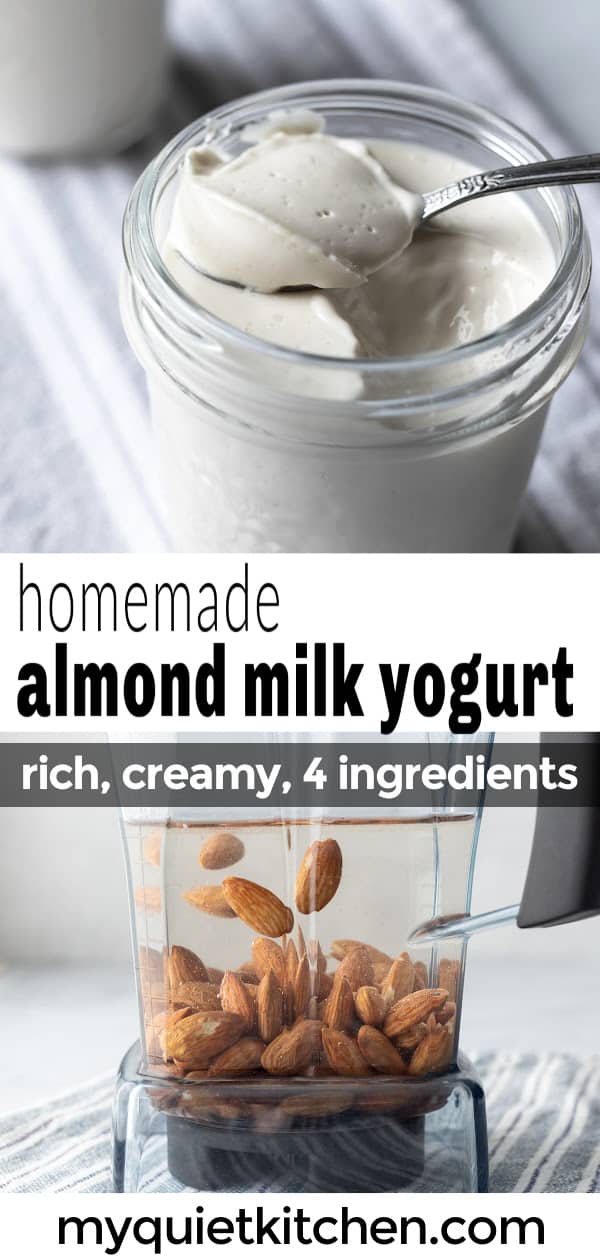
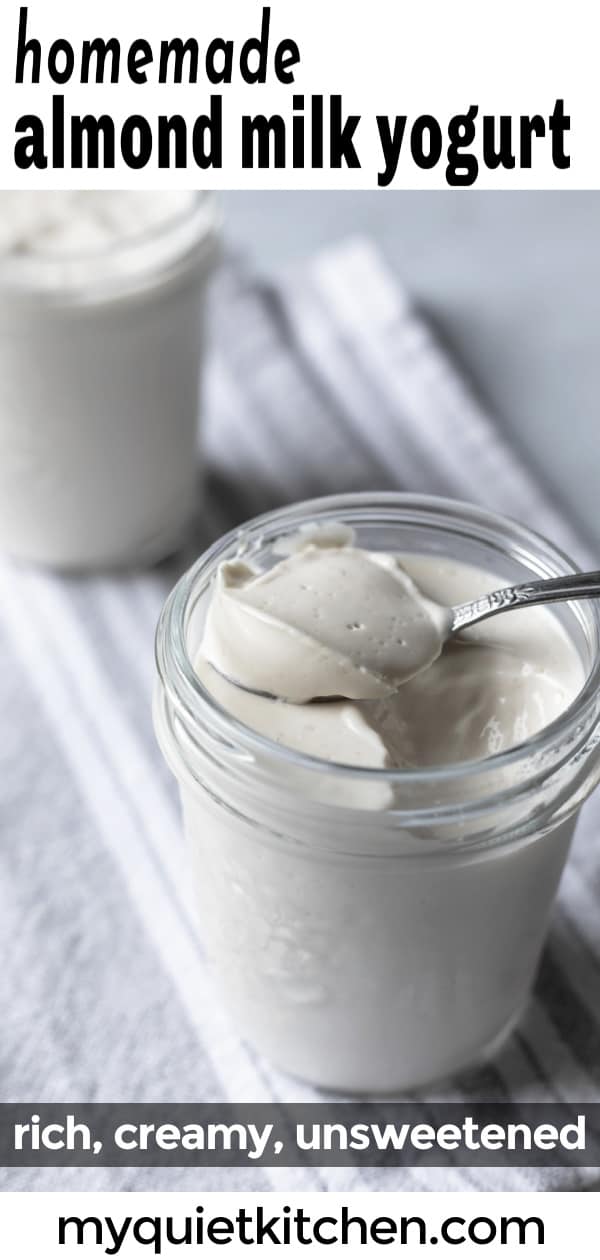
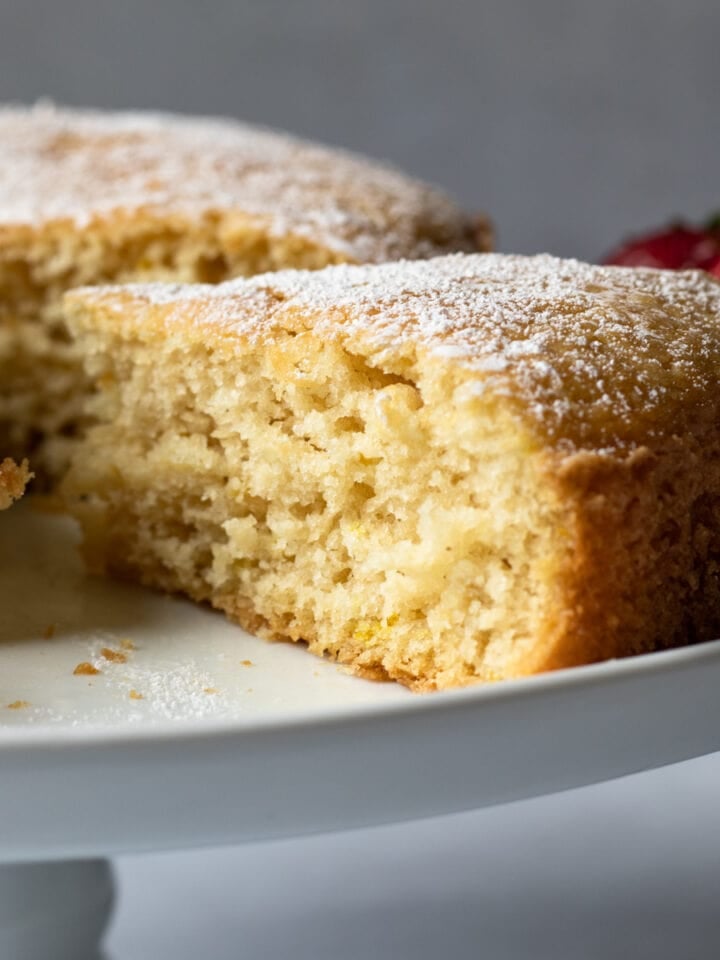
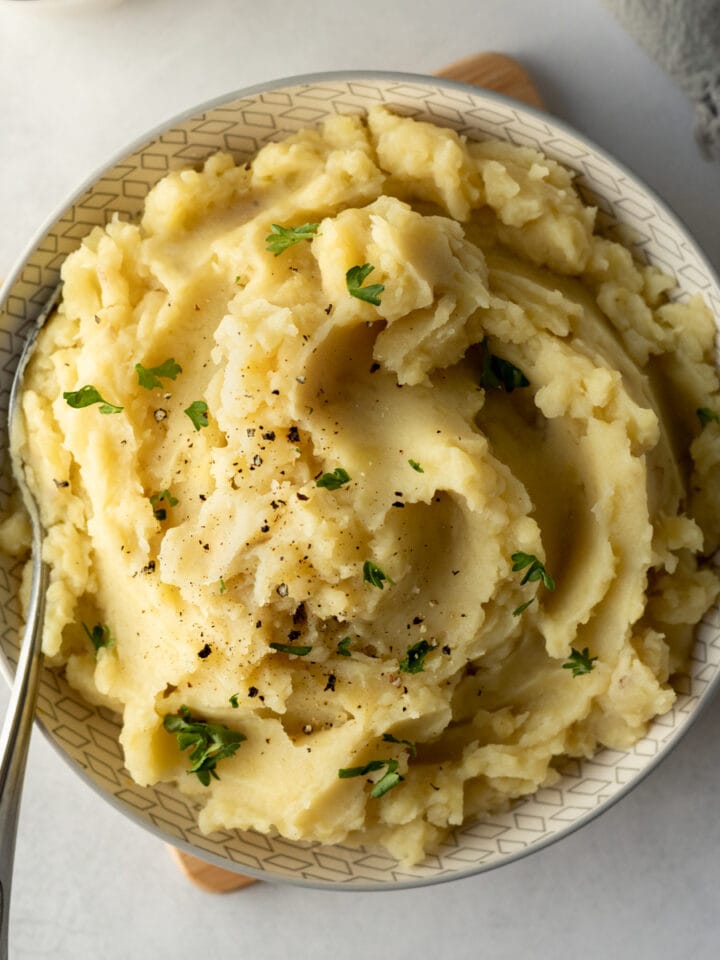
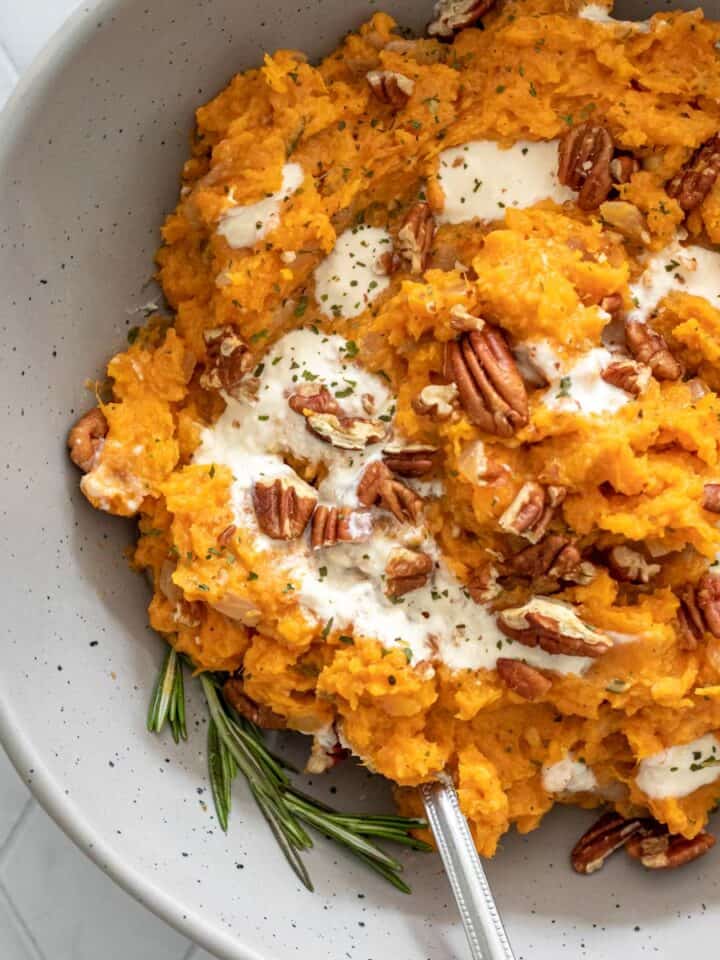
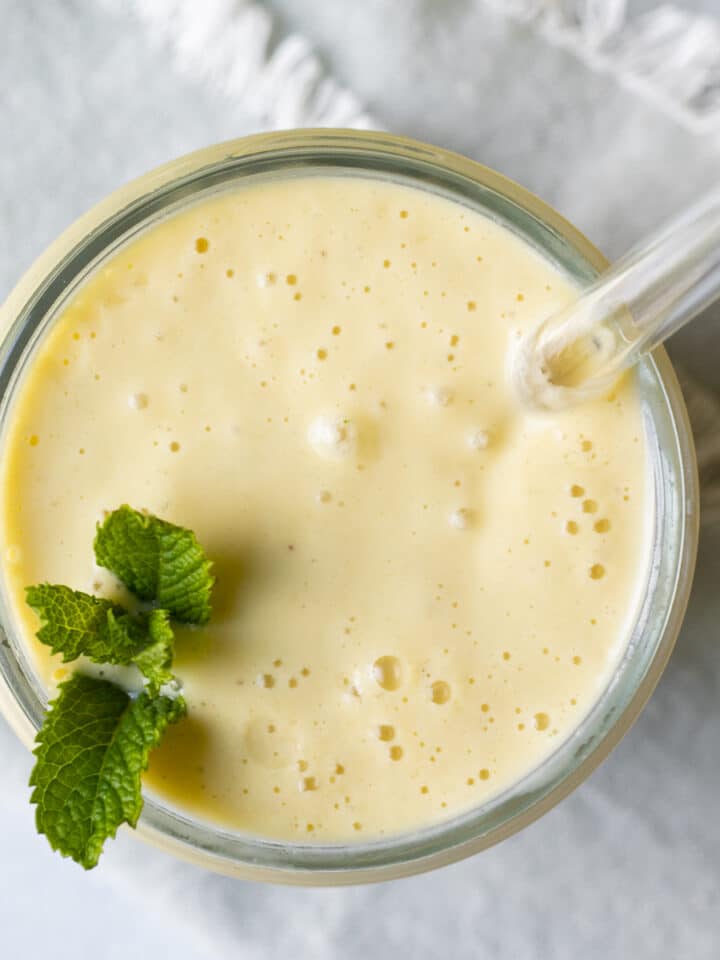
Lori
Hi Kit, it sounds like the bacteria that causes pink yogurt made it into the mixture somehow. If you followed the heating instructions exactly and sterilized the jars, the most likely culprit is probably a utensil (or the yogurt maker?). Probably a freak occurrence, and I hope you'll try again. I updated the Troubleshooting section above to include more information. Hope that helps!
Lavender
I have some almond milk made up already - how much should I use, 2 cups worth?
Lori
Hi, I’d say about 2.5 cups will be close, as the recipe is written.
Lavender
thank you, and thank you for the recipe!
Anita
Followed directions and even used one 40m capsule of the preferred biotic, put in instapot for 12 hrs. It was thin, no thcker than whipping cream. after refrigerating overnight, it separated with lumps and no thicker. whisked and put back in fridge to if will thicken.
Lori
Hi Anita,
Sorry to hear you had trouble with it. If you included the starch and agar and heated it exactly as described, I can't think of a reason why it wouldn't thicken. If you still have all the ingredients, I recommend giving it another try.
Britt
Hi Lori,
I followed your recipe to a T but my yogurt came out more like creamy almond milk. Do you have any suggestions or thoughts as to how I make this a yogurt consistency like your picture?
Thanks a bunch and LOVE your blog!
Lori
Hi Britt,
Hmm, if you followed the recipe exactly I'm not sure! Is it possible the starch you're using is old? Since that and the agar are the main thickeners, another possible cause could be not heating them long enough to activate (or heating them TOO long). Next time you could try using a little bit more of each.
Aside from the consistency, did it taste like yogurt? That will tell us whether it cultured properly. Hope that helps!
Irene
I have tried other yogurt recipes. This is the first one that really works and taste great. I am really looking forward to trying others. Thank you so much. I had given up
Annie
Would it be possible to substitute any other nuts? I'm thinking walnuts in particular, but curious about any of them.
Lori
Hi Annie,
That's a great question. I'm not sure! Cashew is the only other one I've tried so far. Find that here: https://myquietkitchen.com/cashew-yogurt/
Walnut sounds so interesting. I'll have to try that!
Jane
I increased the servings to 12. I'm 99% sure I made no mistakes. Used New Rhythm Probiotics 50 billion CFU. Used my instapot, 14 hours. My yogurt is thin. Thick, but thin.
Did I increase too much? When it simmered, it wasn't real thick then.
Comments, Suggestions?
Lori
Hi Jane,
I've never tripled a batch before so that's definitely something to consider. After simmering it's only mildly thickened by the starch. The agar's gelling isn't apparent until it cools. I'm not familiar with New Rhythm probiotics but that looks like one that should work well. It's difficult to say which factor may have led to thin yogurt. Hopefully it tastes nice and tangy. I would probably experiment with a small batch and try something different, maybe increase the starch slightly. Also, if the starch is old it can lose effectiveness.
Maggie Barrow
Have you ever used almond milk from the store?, like Elmhurst brand, that claim it only has 2 ingredients (water and almonds)
Lori
Hi Maggie, no I haven't. I've never heard of Elmhurt milk or come across one in stores yet that didn't have the gums, etc. If it's truly just almonds and water I'd say it's worth a try!
Sandra Pangestu
Hi Lori, I thoroughly enjoy reading your recipe. I have a dilemma as the only probiotic strain that works for my son is L. Reuteri, which is in tablet form that I need to crush, there's 100-200 millions cfu within each tablet so we're talking about 20-30 tablets within each batch. Aside from cost considerations (Yes, I too wish I can use cheaper option that only uses 1 single capsule probiotics but he has severe gut dysbiosis and that brand is the only one that works amongst many we've tried), will it affect the integrity of final product, using not using ready made powder from capsule and using such large quantity? I'll be using instapot Ninja Foodie brand, do I need to still simmer in heat? Either way, do I have to put them in jars first before putting them in instapot?Can I save some of final product to make next batch? Do we have to consume everything within a week? Can I use metal lid instead of plastic shown in your recipe? How do I make sure I do correctly, what to watch? Sorry for a bunch of questions, just want to make sure I know how to do it since it's my first time ever. Thanks so much in advance and I'll forward to hear from you.
Lori
Hi Sandra,
I don't have experience with that probiotic so you may have to do some experimenting with a batch or two. However, from my research, I've read that acidophilus and B.lactis are necessary for yogurt, so I'm honestly not sure whether the probiotic you use will work or not. Update: just Googled and discovered that L. Reuteri yogurt is definitely a thing! So that sounds promising. You might want to look at some of those articles.
For the Ninja Foodie, yes I recommend still following the instructions for the steps leading up to putting it in the machine to culture. You don't have to put it in jars, but I like to do that to make sure there are no unwanted smells or flavors from the IP that make it into the yogurt. But you can put it directly in the pot.
You can always try using leftover yogurt to culture the next batch, but results aren't as consistent (with nut-based yogurts). This is why I recommend using fresh, potent probiotic each time.
Yes, you can use a metal lid; I recommend that it not touch the top of the yogurt.
I hope that is helpful. I'm sorry that the post wasn't more thorough and you were still left with questions. I plan to update it soon with more information. If you experiment with the probiotic you have do let me know how it goes!
Diane
Can you use regular almond milk from the store or do you have to make it and if you can how many cups of almond milk to make it in the Insta pot?
Lori
Hi Diane,
Store-bought plant milks don't work well for yogurt because of the added stabilizers. The exception being plain soy milk that is made from soybeans and water only. But most almond milk has gums or other stabilizers added, and these can get strange and gloopy during culturing. Hope that helps!
monika
Can I replace the tapioca with something else? I am low-carb.
Thank you.
Lori
Hi Monika,
I've only tested the yogurt with the additional starch, so I'm not sure how the consistency will be if you omit it. I would expect it to be more like kefir. You could also experiment with reducing the starch by half. The amount of carbohydrate added would be minimal. Do let us know if you give it a try!
Raewyn
Dis there value in leaving almond skins on?
Lori
Hi Raewyn, only that it's easier to simply toss the almonds in the blender and then strain with a nut milk bag, as opposed to blanching and removing all of the skins.
Brian
I have a VitaMix blender and when I blend nuts/seeds/fruit there usually isn't any pulp. Makes for a much smoother mix.
Would this have an affect on the yogurt?
Thanks
Lori
Hi Brian,
I also use a Vitamix. With skinless nuts/seeds like cashews I don't have pulp, but since I used almonds that have their skins intact the milk definitely needed to be strained. I usually end up with about 1 cup of pulp fiber after making the milk.